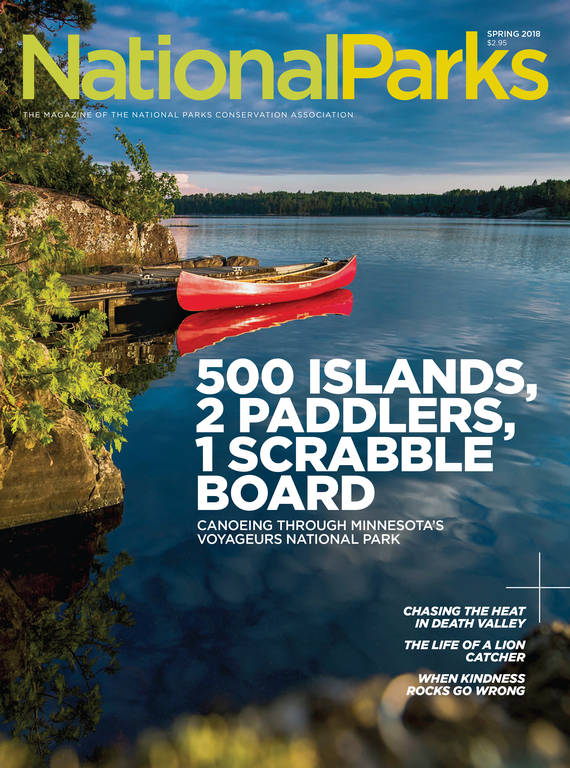Spring 2018
Reporting for Duty
The Park Service shuttered its Morning Report in 2015 after a 30-year run, but the longtime editor has a few more things to say.
For 30 years, many national park devotees around the country began their work days the same way: They’d get a cup of coffee and scan the National Park Service Morning Report. An exploding backcountry toilet? A volunteer impersonating a military officer? A bull that escaped from a nearby rodeo? If it happened in a national park site, odds are it would roll into your inbox by 8 a.m. Eastern time one morning soon after.
Mandatory reading for anyone who wanted a snapshot of what was going on in parks around the country, the mini-publication covered searches, rescues, fires, traffic accidents, drownings, law enforcement, legislative actions, trainings, events, awards and employee news. By turns informative, amusing, cautionary and depressing, the Morning Report was beloved among its followers, both inside and outside the Park Service. Employees credit it with fostering a sense of community, helping to establish agency-wide procedures and standards, and serving as a historical record. Some insist it led to better pay for rangers by painting a fuller picture of the demands of the job.
“It’s such a broadly spread-out agency with so many different kinds of people. It’s hard to keep track of who’s doing what and where,” said Butch Farabee, a former superintendent, search-and-rescue legend and author who worked for the Park Service for 35 years. “That’s where the Morning Report was so valuable.”
Even the report’s greatest fans weren’t all aware that from its inception in 1986 until its demise in 2015, one person served as the editor: Bill Halainen. He frequently rose early, showed up on weekends and worked during vacations, and over those three decades, he churned out nearly 7,000 editions of the report.
“I have enormous regard for the employees of the National Park Service, and, of course, for its mission and truly felt it was an honor and duty to serve them as best I could. That was the fire that lit the burner,” said Halainen, who moved among parks and juggled other responsibilities during those years. “Many readers wrote back — particularly those in small or remote parks — that the Morning Report made them feel like part of the agency, often for the first time in years.”
Initially, Halainen said in a recent conversation, he typed out the reports on IBM Selectric typewriters, stuffed envelopes and mailed out the roundup once a month to chief rangers at parks around the country. That changed with the advent of an internal email system, and by 1988, the bulletin was reborn as the Morning Report and sent out every weekday morning.
Gradually, he added employee addresses to the system, and the report’s reach spread. Though the numbers are squishy, Halainen believes that during the report’s peak years, most of the Park Service staff, currently around 22,000 people, were regular readers. In 2002, he launched InsideNPS, an online version of the report for employees.
What readers tend to remember best are the grisly or outlandish stories — people jokingly referred to it as the Gloom and Doom Report or Morning Mayhem. Halainen, who saw more than 20,000 incident reports go by, said a few still haunt him.
“Every year among all the routine carnage, there would be a couple of dozen that just sucked the air out of you, tragedies or incredibly dumb things people do,” he said.
Reporters would call to ask about the most dangerous things you could do in parks, and the answer was always the same: Drive, get in the water and fall off cliffs. He recalled stories about people underestimating currents or ducking past “do not enter” signs to explore powerful waterfalls or walking into geysers. None of those tales ended well.
To be sure, the report also showcased rangers’ accomplishments and other inspiring stories. Halainen pointed to an item about a 21-year-old seasonal backcountry ranger in Alaska’s Denali National Park & Preserve who was stalked by an aggressive bear. She used an array of tactics, throwing rocks, screaming obscenities, smacking the bear in the head and finally, blasting her radio in the surprised animal’s face. That item remains a favorite, Halainen said, “as it shows ranger ingenuity, courage and persistence in the face of adversity.”
Somehow, 30 years passed. “As long as those guys were reading it, I wasn’t going to give it up,” said Halainen, who continued to work on the report as a contractor after semi-retiring in 2007.
But when Halainen finally retired for real, the sun also set on the Morning Report. Superiors told him that funding had dried up, and the agency had better ways of getting out information. The Park Service moved to a “park-generated InsideNPS intranet platform that allows employees to post and read news from other parks in real-time. Regional and program offices have also developed newsletters,” Jeremy K. Barnum, the agency’s chief spokesperson, said in an email.
That explanation didn’t sit well with the report’s devotees, many of whom are still upset about the decision. “It was a terrible, stupid and arrogant thing to do,” Farabee said. “It left a big hole.”
But that’s not where the story ends. Fortunately for his loyalists, Halainen wasn’t quite done. “November 8, 2016 changed the world in a lot of ways,” he said. “After the election, there was no question I would do something. I thought it was really necessary to get back in the game.”

National Parks
You can read this and other stories about history, nature, culture, art, conservation, travel, science and more in National Parks magazine. Your tax-deductible membership donation of $25 or more entitles…
See more ›Last March, he unveiled the Weekly National Park System Report, a scaled-down version of the old newsletter, which is published by the Coalition to Protect America’s National Parks. The nonprofit advocacy group sends the weekly chronicle to its 1,450 or so members, all former, current or retired Park Service employees. The format is similar: Halainen still covers incidents, fires, park operations and news about agency staff, and a former colleague contributes a section about goings-on in Congress. Halainen’s love for the parks clearly continues to be the guiding principle — and fundamentally, the report’s respectful tone is unchanged — but this go-round, he’s no longer a Park Service employee, and it shows. He’s not shy about linking to articles critical of the Trump administration and has added a closing “observation” — often a quote with an unmistakable point of view. Recently, for example, he shared a High Country News story titled “Interior Department’s return to the ‘robber baron’ years,” and after Interior Secretary Ryan Zinke publicly questioned the loyalty of his employees, the report ended with a quote from Sen. Maria Cantwell (D-Wash.): “The public servants at the Department of the Interior deserve respect from the man charged with leading them — not cheap shots in the press.”
“My objective there is to get as much information out to people as possible,” Halainen said. “I’ll keep doing the weekly edition based on demand, the fate of the administration and the state of the Park Service.”
So what became of all the old Morning Reports? Halainen gave everything to a colleague stationed at the Federal Law Enforcement Training Center in Georgia, but an easily accessible archive does not exist. That complicates things for park enthusiasts following up on a rumor or trying to dig up a piece of history, but fortunately, if all else fails, help is on hand.
“Just call me up,” Halainen said.
About the author
-
 Rona Marech Editor-in-Chief
Rona Marech Editor-in-ChiefRona Marech is the editor-in-chief of National Parks, NPCA’s award-winning magazine. Formerly a staff writer at the Baltimore Sun and the San Francisco Chronicle, Rona joined NPCA in 2013.



